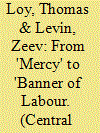| Srl | Item |
| 1 |
ID:
184421


|
|
|
|
|
| Summary/Abstract |
This paper presents the development and transformations of Bukharan Jewish newspapers and periodicals (1910–38) and situates them in the broader Central Asian mediascape. Over a period of 30 years, the Bukharan Jewish press was transformed from a pioneering privately owned enterprise that served the needs of the Jewish communities throughout Central Asia to one owned and regulated by the Soviet state, serving as a tool to transmit propaganda and to shape and educate a predefined ‘national minority group’. The paper argues that the introduction of a Bukharan Jewish press in 1910 was intended to create a modernized language and ethnic awareness among the Jews of Central Asia. In the 1930s, Bukharan Jewish newspapers and journals were radically Sovietized and finally shut down by the state. From then until the collapse of the Soviet Union, no Bukharan Jewish publications appeared in the bloc and the existence of a distinct Central Asian Jewish identity was largely ignored. This case study sheds light on Tsarist and Soviet minorities’ policies and helps us to better understand the various changes experienced and the cultural adaptations made by many ‘minorities’ of Central Asia in the Age of Colonialism.
|
|
|
|
|
|
|
|
|
|
|
|
|
|
|
|
| 2 |
ID:
185876


|
|
|
|
|
| Summary/Abstract |
Despite being in operation for a mere five years, the Soviet-era Tajik (Persian) journal Rahbar-i Dānish (1927–1932) was a key venue for exploring and debating the merits of Tajik literature in the context of new ideological and literary trends. Established litterateurs as well as literary newcomers published examples of their literature and literary criticism in this first Tajik monthly social, educational, and literary journal. The present article reviews the history of Rahbar-i Dānish and some of its authors to trace their influence on Tajik literature and literary criticism in the late 1920s and early 1930s. The article addresses the difficulties of creating a Soviet Tajik literature and scrutinizes the various genres featured in the literary section of the journal. Finally, it presents the trajectories of two literary newcomers, Jalāl al-Dīn Ikrām (who later became known as Jalol Ikromi) and Baḥr al-Dīn ʿAzīzī (who died in a Soviet prison in 1944), whose short stories were most prominent in Rahbar-i Dānish. This article is based on an almost complete set of the forty-five issues of the journal, published between August 1927 and March 1932.
|
|
|
|
|
|
|
|
|
|
|
|
|
|
|
|